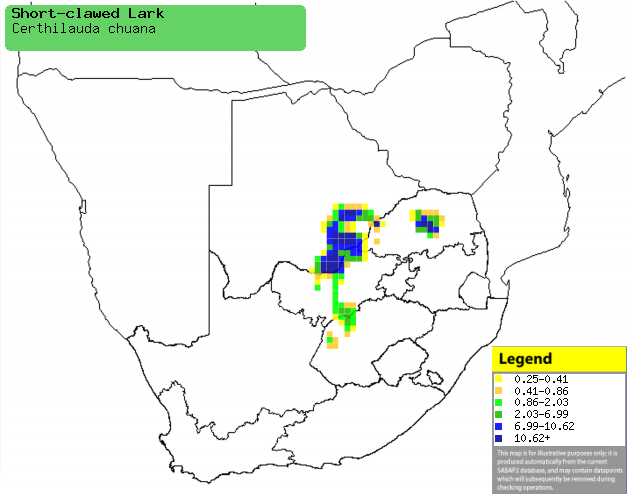|
Certhilauda chuana (Short-clawed lark)
[= Mirafra chuana]
Kortkloulewerik [Afrikaans]; Botswana-leeuwerik [Dutch]; Alouette à
ongles courts [French]; Betschuanalerche [German]; Cotovia-d'unhas-curtas
[Portuguese]
Life
> Eukaryotes >
Opisthokonta
> Metazoa (animals) >
Bilateria >
Deuterostomia > Chordata >
Craniata > Vertebrata (vertebrates) > Gnathostomata (jawed
vertebrates) > Teleostomi (teleost fish) > Osteichthyes (bony fish) > Class:
Sarcopterygii (lobe-finned
fish) > Stegocephalia (terrestrial
vertebrates) > Tetrapoda
(four-legged vertebrates) > Reptiliomorpha > Amniota >
Reptilia (reptiles) >
Romeriida > Diapsida > Archosauromorpha > Archosauria >
Dinosauria
(dinosaurs) > Saurischia > Theropoda (bipedal predatory dinosaurs) >
Coelurosauria > Maniraptora > Aves
(birds) > Order: Passeriformes
> Family: Alaudidae
> Genus: Certhilauda
Distribution and habitat
Endemic to southern Africa, occurring from south-eastern
Botswana to the North-west Province, Free State and Limpopo Province. It
generally prefers semi-arid Acacia savanna with scattered grass clumps
and bushes, with large patches of bare ground.
|
 |
|
Distribution of Short-clawed lark in southern Africa,
based on statistical smoothing of the records from first SA Bird Atlas
Project (©
Animal Demography unit, University of
Cape Town; smoothing by Birgit Erni and Francesca Little). Colours range
from dark blue (most common) through to yellow (least common).
See here for the latest distribution
from the SABAP2. |
Food
It almost exclusively eats insects (mainly ants and
termites), gleaning them from bare soil and vegetation. The following food items have been recorded
in its diet:
Breeding
- The nest is built solely by the female in about 5 days, consisting of open
cup built of grass and lined with finer plant material. It is typically
placed in a scrape in the ground beneath a grass tuft or small shrub, often
with scattered nest material surrounding it.
- Egg-laying season is from September-March, peaking from
October-February.
- It lays 2-3 eggs, which are incubated solely by the female for about
14-16 days. Temperatures can get above 41° Celsius but the nest can get even
get to above 50° Celsius, making it even more necessary for the female to
shade the eggs, despite her own discomfort.
- The chicks are brooded for the first few days of their lives, especially
around midday when the sun is at its hottest. They are fed by both parents,
leaving the nest after about 11-12 days, before they are able to fly,
spending the next few weeks hiding in dense vegetation. They remain
dependent on their parents for food up to about 4 weeks of age, only
dispersing about another 4-12 weeks later.
Threats
Near-threatened, due its fragmented and localised
distribution, and because it is not particularly common in protected areas. In
fact, most of its population is located in degraded communal tribal land in
south-eastern Botswana, where changes in land use could cause serious problems
for the species.
References
-
Hockey PAR, Dean WRJ and Ryan PG 2005. Roberts
- Birds of southern Africa, VIIth ed. The Trustees of the John Voelcker
Bird Book Fund, Cape Town.
|
